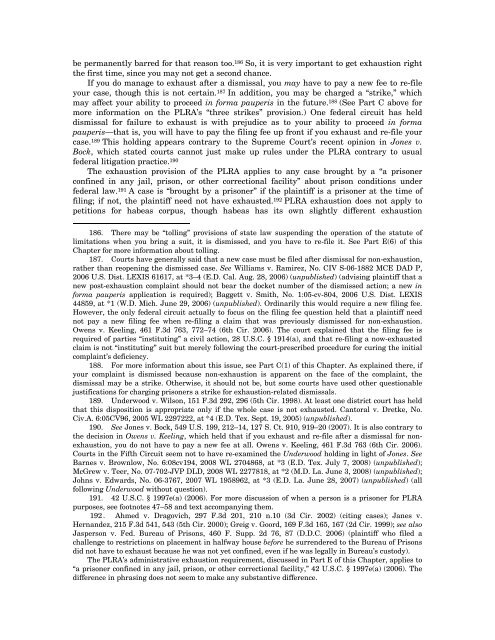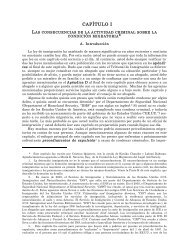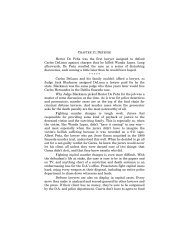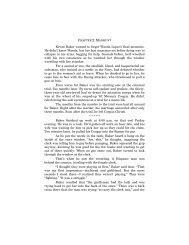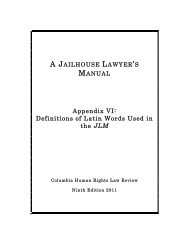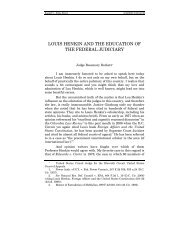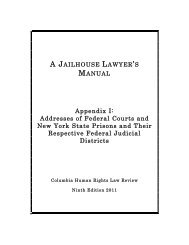A Jailhouse Lawyer's Manual Chapter 14 - Columbia Law School
A Jailhouse Lawyer's Manual Chapter 14 - Columbia Law School
A Jailhouse Lawyer's Manual Chapter 14 - Columbia Law School
You also want an ePaper? Increase the reach of your titles
YUMPU automatically turns print PDFs into web optimized ePapers that Google loves.
e permanently barred for that reason too. 186 So, it is very important to get exhaustion right<br />
the first time, since you may not get a second chance.<br />
If you do manage to exhaust after a dismissal, you may have to pay a new fee to re-file<br />
your case, though this is not certain. 187 In addition, you may be charged a “strike,” which<br />
may affect your ability to proceed in forma pauperis in the future. 188 (See Part C above for<br />
more information on the PLRA’s “three strikes” provision.) One federal circuit has held<br />
dismissal for failure to exhaust is with prejudice as to your ability to proceed in forma<br />
pauperis—that is, you will have to pay the filing fee up front if you exhaust and re-file your<br />
case. 189 This holding appears contrary to the Supreme Court’s recent opinion in Jones v.<br />
Bock, which stated courts cannot just make up rules under the PLRA contrary to usual<br />
federal litigation practice. 190<br />
The exhaustion provision of the PLRA applies to any case brought by a “a prisoner<br />
confined in any jail, prison, or other correctional facility” about prison conditions under<br />
federal law. 191 A case is “brought by a prisoner” if the plaintiff is a prisoner at the time of<br />
filing; if not, the plaintiff need not have exhausted. 192 PLRA exhaustion does not apply to<br />
petitions for habeas corpus, though habeas has its own slightly different exhaustion<br />
186. There may be “tolling” provisions of state law suspending the operation of the statute of<br />
limitations when you bring a suit, it is dismissed, and you have to re-file it. See Part E(6) of this<br />
<strong>Chapter</strong> for more information about tolling.<br />
187. Courts have generally said that a new case must be filed after dismissal for non-exhaustion,<br />
rather than reopening the dismissed case. See Williams v. Ramirez, No. CIV S-06-1882 MCE DAD P,<br />
2006 U.S. Dist. LEXIS 61617, at *3–4 (E.D. Cal. Aug. 28, 2006) (unpublished) (advising plaintiff that a<br />
new post-exhaustion complaint should not bear the docket number of the dismissed action; a new in<br />
forma pauperis application is required); Baggett v. Smith, No. 1:05-cv-804, 2006 U.S. Dist. LEXIS<br />
44859, at *1 (W.D. Mich. June 29, 2006) (unpublished). Ordinarily this would require a new filing fee.<br />
However, the only federal circuit actually to focus on the filing fee question held that a plaintiff need<br />
not pay a new filing fee when re-filing a claim that was previously dismissed for non-exhaustion.<br />
Owens v. Keeling, 461 F.3d 763, 772–74 (6th Cir. 2006). The court explained that the filing fee is<br />
required of parties “instituting” a civil action, 28 U.S.C. § 19<strong>14</strong>(a), and that re-filing a now-exhausted<br />
claim is not “instituting” suit but merely following the court-prescribed procedure for curing the initial<br />
complaint’s deficiency.<br />
188. For more information about this issue, see Part C(1) of this <strong>Chapter</strong>. As explained there, if<br />
your complaint is dismissed because non-exhaustion is apparent on the face of the complaint, the<br />
dismissal may be a strike. Otherwise, it should not be, but some courts have used other questionable<br />
justifications for charging prisoners a strike for exhaustion-related dismissals.<br />
189. Underwood v. Wilson, 151 F.3d 292, 296 (5th Cir. 1998). At least one district court has held<br />
that this disposition is appropriate only if the whole case is not exhausted. Cantoral v. Dretke, No.<br />
Civ.A. 6:05CV96, 2005 WL 2297222, at *4 (E.D. Tex. Sept. 19, 2005) (unpublished).<br />
190. See Jones v. Bock, 549 U.S. 199, 212–<strong>14</strong>, 127 S. Ct. 910, 919–20 (2007). It is also contrary to<br />
the decision in Owens v. Keeling, which held that if you exhaust and re-file after a dismissal for nonexhaustion,<br />
you do not have to pay a new fee at all. Owens v. Keeling, 461 F.3d 763 (6th Cir. 2006).<br />
Courts in the Fifth Circuit seem not to have re-examined the Underwood holding in light of Jones. See<br />
Barnes v. Brownlow, No. 6:08cv194, 2008 WL 2704868, at *3 (E.D. Tex. July 7, 2008) (unpublished);<br />
McGrew v. Teer, No. 07-702-JVP DLD, 2008 WL 2277818, at *2 (M.D. La. June 3, 2008) (unpublished);<br />
Johns v. Edwards, No. 06-3767, 2007 WL 1958962, at *3 (E.D. La. June 28, 2007) (unpublished) (all<br />
following Underwood without question).<br />
191. 42 U.S.C. § 1997e(a) (2006). For more discussion of when a person is a prisoner for PLRA<br />
purposes, see footnotes 47–58 and text accompanying them.<br />
192 . Ahmed v. Dragovich, 297 F.3d 201, 210 n.10 (3d Cir. 2002) (citing cases); Janes v.<br />
Hernandez, 215 F.3d 541, 543 (5th Cir. 2000); Greig v. Goord, 169 F.3d 165, 167 (2d Cir. 1999); see also<br />
Jasperson v. Fed. Bureau of Prisons, 460 F. Supp. 2d 76, 87 (D.D.C. 2006) (plaintiff who filed a<br />
challenge to restrictions on placement in halfway house before he surrendered to the Bureau of Prisons<br />
did not have to exhaust because he was not yet confined, even if he was legally in Bureau’s custody).<br />
The PLRA’s administrative exhaustion requirement, discussed in Part E of this <strong>Chapter</strong>, applies to<br />
“a prisoner confined in any jail, prison, or other correctional facility,” 42 U.S.C. § 1997e(a) (2006). The<br />
difference in phrasing does not seem to make any substantive difference.


